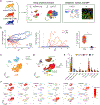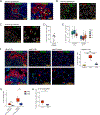The immune landscape in tuberculosis reveals populations linked to disease and latency
- PMID: 33340449
- PMCID: PMC7878437
- DOI: 10.1016/j.chom.2020.11.013
The immune landscape in tuberculosis reveals populations linked to disease and latency
Abstract
Tuberculosis (TB), caused by Mycobacterium tuberculosis (Mtb) latently infects approximately one-fourth of the world's population. The immune mechanisms that govern progression from latent (LTBI) to active pulmonary TB (PTB) remain poorly defined. Experimentally Mtb-infected non-human primates (NHP) mirror the disease observed in humans and recapitulate both PTB and LTBI. We characterized the lung immune landscape in NHPs with LTBI and PTB using high-throughput technologies. Three defining features of PTB in macaque lungs include the influx of plasmacytoid dendritic cells (pDCs), an Interferon (IFN)-responsive macrophage population, and activated T cell responses. In contrast, a CD27+ Natural killer (NK) cell subset accumulated in the lungs of LTBI macaques. This NK cell population was also detected in the circulation of LTBI individuals. This comprehensive analysis of the lung immune landscape will improve the understanding of TB immunopathogenesis, providing potential targets for therapies and vaccines for TB control.
Keywords: NK cells; granulomas; immune protection; lung; pDCs; single cell technologies; tuberculosis; type I IFNs.
Copyright © 2020 Elsevier Inc. All rights reserved.
Conflict of interest statement
Declaration of interests The authors declare no competing interests.
Figures






Comment in
-
Immunologic goalposts for TB vaccine development.Cell Host Microbe. 2021 Feb 10;29(2):158-159. doi: 10.1016/j.chom.2021.01.011. Cell Host Microbe. 2021. PMID: 33571443 Free PMC article.
References
-
- (WHO), W.H.O. (2018). Global tuberculosis report 2018. https://wwwwhoint/tb/publications/global_report/en/.
-
- Antonelli LR, Gigliotti Rothfuchs A, Goncalves R, Roffe E, Cheever AW, Bafica A, Salazar AM, Feng CG, and Sher A (2010). Intranasal Poly-IC treatment exacerbates tuberculosis in mice through the pulmonary recruitment of a pathogen-permissive monocyte/macrophage population. J Clin Invest 120, 1674–1682. - PMC - PubMed
Publication types
MeSH terms
Grants and funding
- R01 AI123780/AI/NIAID NIH HHS/United States
- R01 AI134236/AI/NIAID NIH HHS/United States
- R01 AI111914/AI/NIAID NIH HHS/United States
- R01 AI155024/AI/NIAID NIH HHS/United States
- R01 HL105427/HL/NHLBI NIH HHS/United States
- P01 AG051428/AG/NIA NIH HHS/United States
- R01 AI134240/AI/NIAID NIH HHS/United States
- P51 OD011133/OD/NIH HHS/United States
- U19 AI091036/AI/NIAID NIH HHS/United States
- S10 OD028732/OD/NIH HHS/United States
- U42 OD010442/OD/NIH HHS/United States
- R01 AI111943/AI/NIAID NIH HHS/United States
- P51 OD011104/OD/NIH HHS/United States
LinkOut - more resources
Full Text Sources
Other Literature Sources
Molecular Biology Databases
Research Materials

